Recruiting the Right Sales Staff for Our Organisation
VerifiedAdded on 2019/09/24
|15
|2982
|219
Report
AI Summary
The assignment content discusses the steps involved in recruiting a sales staff, including seeking permissions from the Sales head and Human Resource Department head, reviewing staff levels, preparing job profiles and specifications, identifying competencies required in a sales personnel, and conducting interviews. The process requires preparation of necessary documents, including job descriptions and specifications, as well as evaluation of candidates based on their performance, knowledge, skills, and experience. The content also highlights the importance of reference checks and non-discrimination during the selection process.
Contribute Materials
Your contribution can guide someone’s learning journey. Share your
documents today.
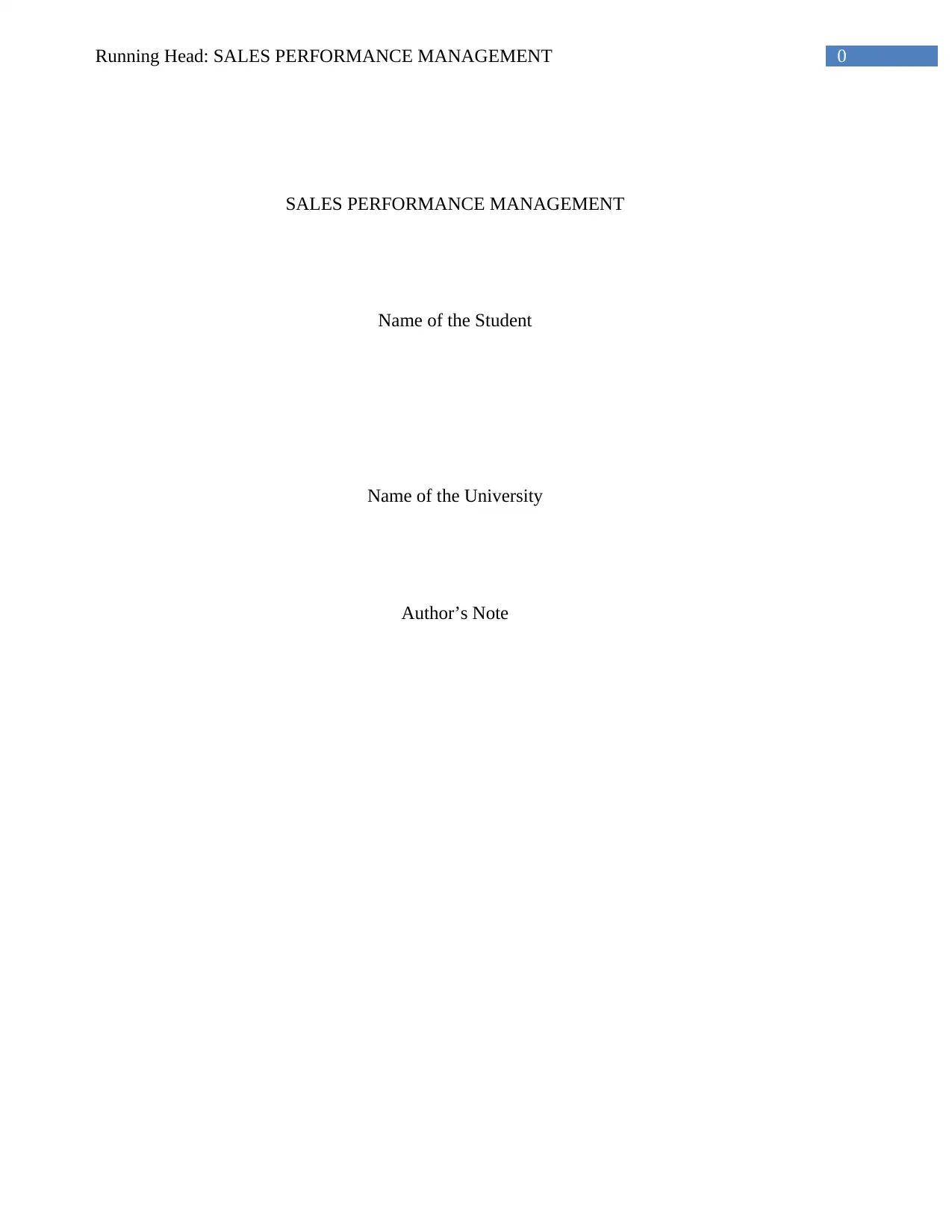
0Running Head: SALES PERFORMANCE MANAGEMENT
SALES PERFORMANCE MANAGEMENT
Name of the Student
Name of the University
Author’s Note
SALES PERFORMANCE MANAGEMENT
Name of the Student
Name of the University
Author’s Note
Secure Best Marks with AI Grader
Need help grading? Try our AI Grader for instant feedback on your assignments.

1SALES PERFORMANCE MANAGEMENT
Table of Contents
Task 1........................................................................................................................................................2
Introduction...............................................................................................................................................2
SPM..........................................................................................................................................................2
Theories of Motivation.............................................................................................................................3
KPIs..........................................................................................................................................................4
Recommendations and conclusions..........................................................................................................5
References for Task 1:..............................................................................................................................6
Task 2........................................................................................................................................................7
Introduction...............................................................................................................................................7
Recruitment Permissions..........................................................................................................................7
Reviewing staff levels...............................................................................................................................8
Difference between Job Profile and Job Specification.............................................................................8
Competencies required in a sales personnel.............................................................................................9
Questions to check sales competency.......................................................................................................9
Resources needed for conducting interview...........................................................................................10
Guidelines on selection and recruitment.................................................................................................10
Draft Time table for an Interview...........................................................................................................11
Conclusion..............................................................................................................................................11
Table of Contents
Task 1........................................................................................................................................................2
Introduction...............................................................................................................................................2
SPM..........................................................................................................................................................2
Theories of Motivation.............................................................................................................................3
KPIs..........................................................................................................................................................4
Recommendations and conclusions..........................................................................................................5
References for Task 1:..............................................................................................................................6
Task 2........................................................................................................................................................7
Introduction...............................................................................................................................................7
Recruitment Permissions..........................................................................................................................7
Reviewing staff levels...............................................................................................................................8
Difference between Job Profile and Job Specification.............................................................................8
Competencies required in a sales personnel.............................................................................................9
Questions to check sales competency.......................................................................................................9
Resources needed for conducting interview...........................................................................................10
Guidelines on selection and recruitment.................................................................................................10
Draft Time table for an Interview...........................................................................................................11
Conclusion..............................................................................................................................................11

2SALES PERFORMANCE MANAGEMENT
References of Task 2..............................................................................................................................12
References of Task 2..............................................................................................................................12
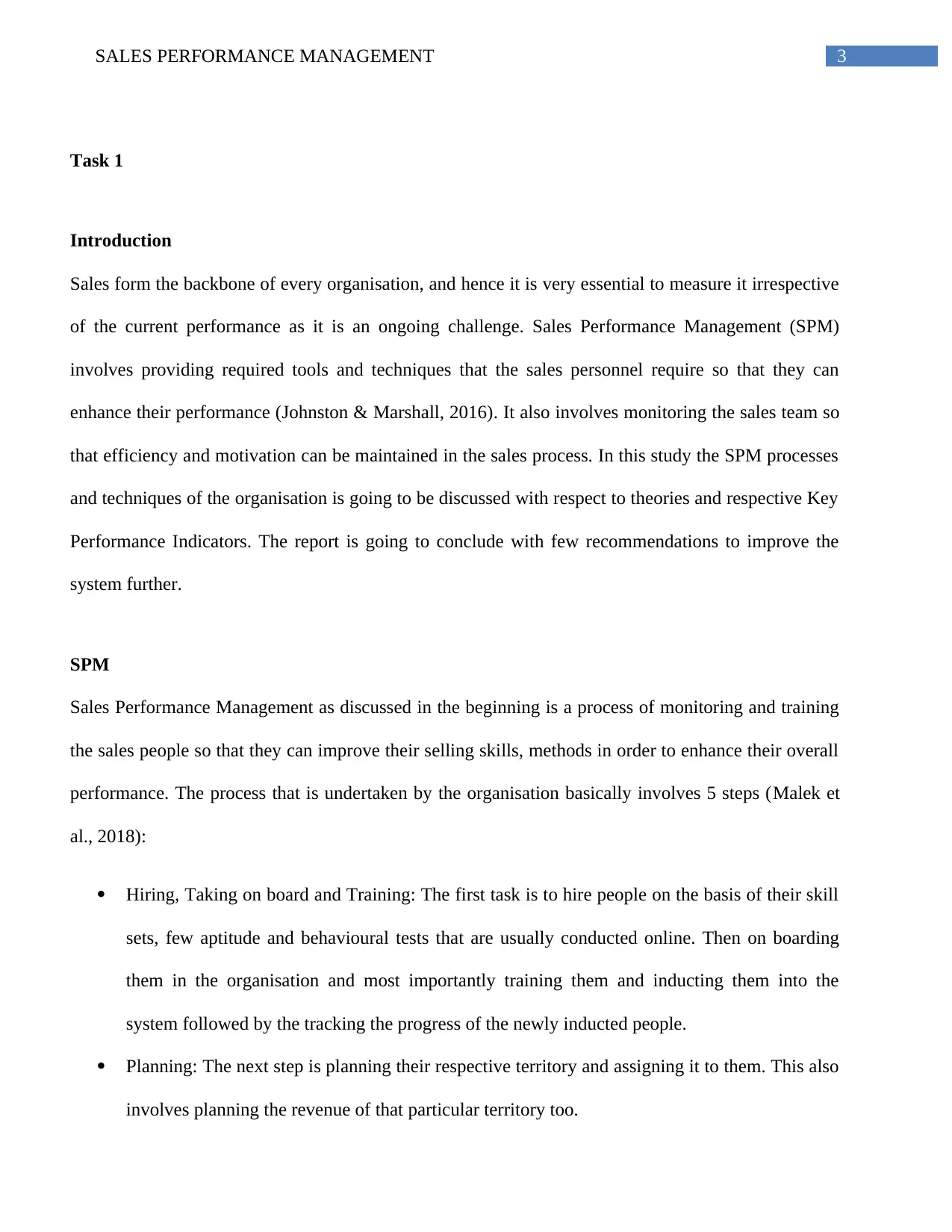
3SALES PERFORMANCE MANAGEMENT
Task 1
Introduction
Sales form the backbone of every organisation, and hence it is very essential to measure it irrespective
of the current performance as it is an ongoing challenge. Sales Performance Management (SPM)
involves providing required tools and techniques that the sales personnel require so that they can
enhance their performance (Johnston & Marshall, 2016). It also involves monitoring the sales team so
that efficiency and motivation can be maintained in the sales process. In this study the SPM processes
and techniques of the organisation is going to be discussed with respect to theories and respective Key
Performance Indicators. The report is going to conclude with few recommendations to improve the
system further.
SPM
Sales Performance Management as discussed in the beginning is a process of monitoring and training
the sales people so that they can improve their selling skills, methods in order to enhance their overall
performance. The process that is undertaken by the organisation basically involves 5 steps (Malek et
al., 2018):
Hiring, Taking on board and Training: The first task is to hire people on the basis of their skill
sets, few aptitude and behavioural tests that are usually conducted online. Then on boarding
them in the organisation and most importantly training them and inducting them into the
system followed by the tracking the progress of the newly inducted people.
Planning: The next step is planning their respective territory and assigning it to them. This also
involves planning the revenue of that particular territory too.
Task 1
Introduction
Sales form the backbone of every organisation, and hence it is very essential to measure it irrespective
of the current performance as it is an ongoing challenge. Sales Performance Management (SPM)
involves providing required tools and techniques that the sales personnel require so that they can
enhance their performance (Johnston & Marshall, 2016). It also involves monitoring the sales team so
that efficiency and motivation can be maintained in the sales process. In this study the SPM processes
and techniques of the organisation is going to be discussed with respect to theories and respective Key
Performance Indicators. The report is going to conclude with few recommendations to improve the
system further.
SPM
Sales Performance Management as discussed in the beginning is a process of monitoring and training
the sales people so that they can improve their selling skills, methods in order to enhance their overall
performance. The process that is undertaken by the organisation basically involves 5 steps (Malek et
al., 2018):
Hiring, Taking on board and Training: The first task is to hire people on the basis of their skill
sets, few aptitude and behavioural tests that are usually conducted online. Then on boarding
them in the organisation and most importantly training them and inducting them into the
system followed by the tracking the progress of the newly inducted people.
Planning: The next step is planning their respective territory and assigning it to them. This also
involves planning the revenue of that particular territory too.
Paraphrase This Document
Need a fresh take? Get an instant paraphrase of this document with our AI Paraphraser

4SALES PERFORMANCE MANAGEMENT
Appraisals and Coaching: Appraisals and coaching the sales personnel is very integral for their
sales growth. This helps in giving suitable feedback on individual performance of the team.
Compensation and Rewards: Money and recognition are the two most effective motivators in
improving performance. Hence it is necessary that both reward and compensation are
comprehensive so that it is able to motivate the personnel to perform better.
Gamification techniques being introduced: Gamification is a very good endeavour to monitor
the performance of each other in order to realize the goals through collaborated efforts.
The organisation uses these tools as it helps in touching all aspects of the sales process and it directly
influences the revenue earning. This particular tool not only helps in monitoring individual
performance but also helps in removing the bad hires at very onset.
Theories of Motivation
There are several theories that have given justification for motivation and performance. The four
theories that can be applied in the workplace to aid the sales performance processes and procedures
are:
Hertzberg’s Two-factor theory, a dual factor theory emphasizes on 2 main factors that impact
motivation of employees are Motivator factors and Hygiene Factors. These two independent factors
work towards the successfully creating conditions for better performance. When both factors are taken
care of the work force becomes the happiest and most productive. During coaching and appraisals
employees should be appreciated and supported so that they can grow within the company. Maslow’s
Hierarchy of needs theory elucidates that in order to achieve higher needs; it is first required to meet
his basic needs (Lepper & Greene, 2015). Basic needs like psychological needs, safety needs, need for
love and need for esteem and respect. In the workplace it is required to explain the staff the importance
Appraisals and Coaching: Appraisals and coaching the sales personnel is very integral for their
sales growth. This helps in giving suitable feedback on individual performance of the team.
Compensation and Rewards: Money and recognition are the two most effective motivators in
improving performance. Hence it is necessary that both reward and compensation are
comprehensive so that it is able to motivate the personnel to perform better.
Gamification techniques being introduced: Gamification is a very good endeavour to monitor
the performance of each other in order to realize the goals through collaborated efforts.
The organisation uses these tools as it helps in touching all aspects of the sales process and it directly
influences the revenue earning. This particular tool not only helps in monitoring individual
performance but also helps in removing the bad hires at very onset.
Theories of Motivation
There are several theories that have given justification for motivation and performance. The four
theories that can be applied in the workplace to aid the sales performance processes and procedures
are:
Hertzberg’s Two-factor theory, a dual factor theory emphasizes on 2 main factors that impact
motivation of employees are Motivator factors and Hygiene Factors. These two independent factors
work towards the successfully creating conditions for better performance. When both factors are taken
care of the work force becomes the happiest and most productive. During coaching and appraisals
employees should be appreciated and supported so that they can grow within the company. Maslow’s
Hierarchy of needs theory elucidates that in order to achieve higher needs; it is first required to meet
his basic needs (Lepper & Greene, 2015). Basic needs like psychological needs, safety needs, need for
love and need for esteem and respect. In the workplace it is required to explain the staff the importance
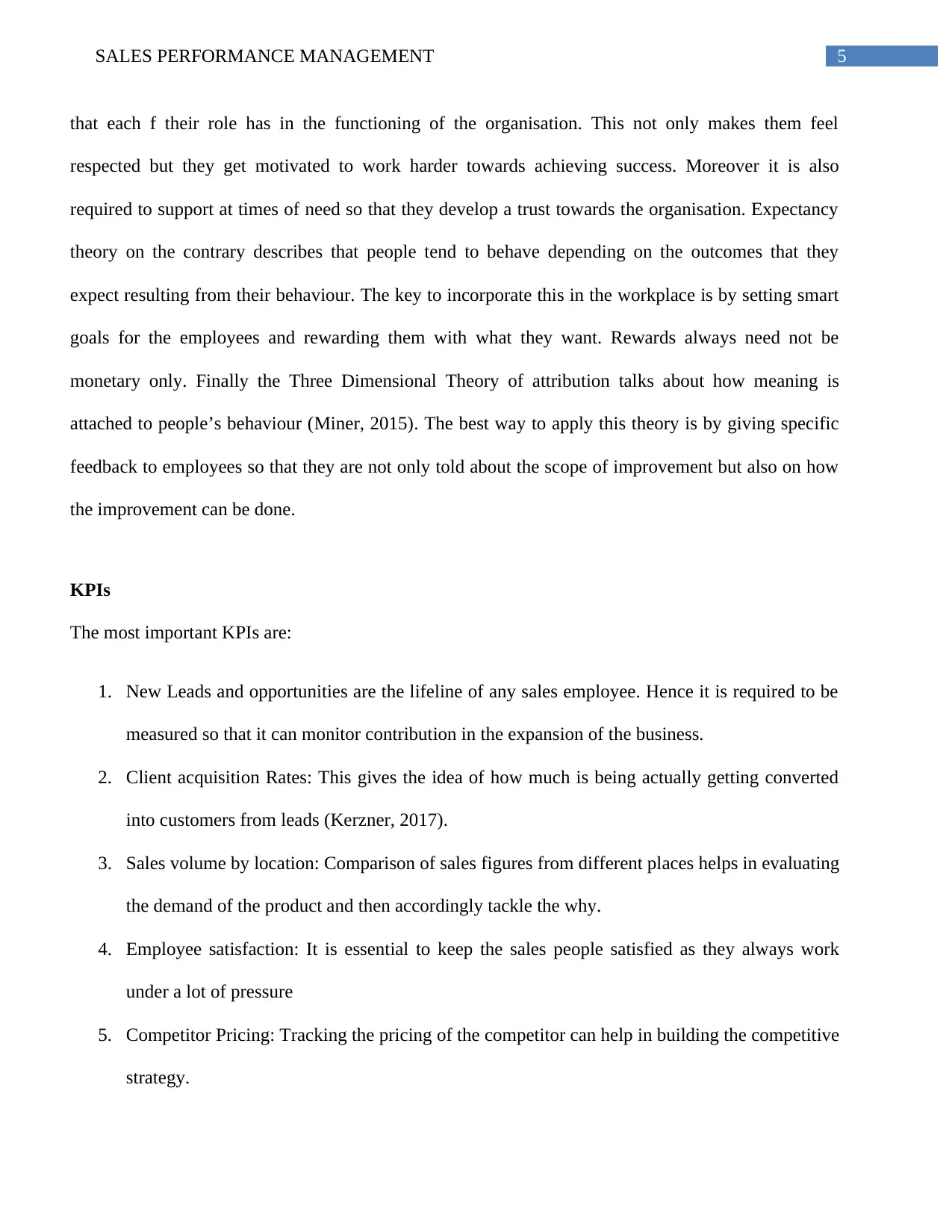
5SALES PERFORMANCE MANAGEMENT
that each f their role has in the functioning of the organisation. This not only makes them feel
respected but they get motivated to work harder towards achieving success. Moreover it is also
required to support at times of need so that they develop a trust towards the organisation. Expectancy
theory on the contrary describes that people tend to behave depending on the outcomes that they
expect resulting from their behaviour. The key to incorporate this in the workplace is by setting smart
goals for the employees and rewarding them with what they want. Rewards always need not be
monetary only. Finally the Three Dimensional Theory of attribution talks about how meaning is
attached to people’s behaviour (Miner, 2015). The best way to apply this theory is by giving specific
feedback to employees so that they are not only told about the scope of improvement but also on how
the improvement can be done.
KPIs
The most important KPIs are:
1. New Leads and opportunities are the lifeline of any sales employee. Hence it is required to be
measured so that it can monitor contribution in the expansion of the business.
2. Client acquisition Rates: This gives the idea of how much is being actually getting converted
into customers from leads (Kerzner, 2017).
3. Sales volume by location: Comparison of sales figures from different places helps in evaluating
the demand of the product and then accordingly tackle the why.
4. Employee satisfaction: It is essential to keep the sales people satisfied as they always work
under a lot of pressure
5. Competitor Pricing: Tracking the pricing of the competitor can help in building the competitive
strategy.
that each f their role has in the functioning of the organisation. This not only makes them feel
respected but they get motivated to work harder towards achieving success. Moreover it is also
required to support at times of need so that they develop a trust towards the organisation. Expectancy
theory on the contrary describes that people tend to behave depending on the outcomes that they
expect resulting from their behaviour. The key to incorporate this in the workplace is by setting smart
goals for the employees and rewarding them with what they want. Rewards always need not be
monetary only. Finally the Three Dimensional Theory of attribution talks about how meaning is
attached to people’s behaviour (Miner, 2015). The best way to apply this theory is by giving specific
feedback to employees so that they are not only told about the scope of improvement but also on how
the improvement can be done.
KPIs
The most important KPIs are:
1. New Leads and opportunities are the lifeline of any sales employee. Hence it is required to be
measured so that it can monitor contribution in the expansion of the business.
2. Client acquisition Rates: This gives the idea of how much is being actually getting converted
into customers from leads (Kerzner, 2017).
3. Sales volume by location: Comparison of sales figures from different places helps in evaluating
the demand of the product and then accordingly tackle the why.
4. Employee satisfaction: It is essential to keep the sales people satisfied as they always work
under a lot of pressure
5. Competitor Pricing: Tracking the pricing of the competitor can help in building the competitive
strategy.
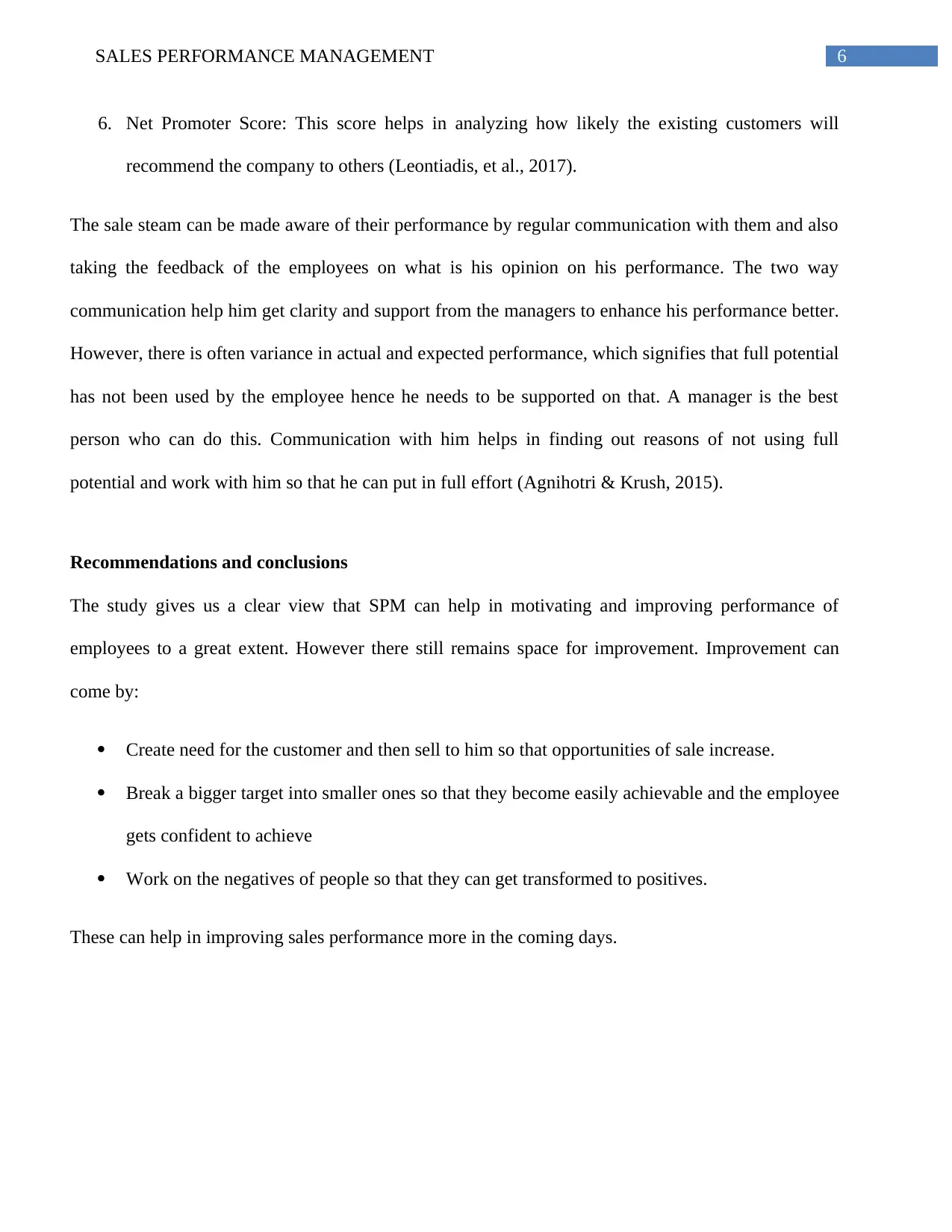
6SALES PERFORMANCE MANAGEMENT
6. Net Promoter Score: This score helps in analyzing how likely the existing customers will
recommend the company to others (Leontiadis, et al., 2017).
The sale steam can be made aware of their performance by regular communication with them and also
taking the feedback of the employees on what is his opinion on his performance. The two way
communication help him get clarity and support from the managers to enhance his performance better.
However, there is often variance in actual and expected performance, which signifies that full potential
has not been used by the employee hence he needs to be supported on that. A manager is the best
person who can do this. Communication with him helps in finding out reasons of not using full
potential and work with him so that he can put in full effort (Agnihotri & Krush, 2015).
Recommendations and conclusions
The study gives us a clear view that SPM can help in motivating and improving performance of
employees to a great extent. However there still remains space for improvement. Improvement can
come by:
Create need for the customer and then sell to him so that opportunities of sale increase.
Break a bigger target into smaller ones so that they become easily achievable and the employee
gets confident to achieve
Work on the negatives of people so that they can get transformed to positives.
These can help in improving sales performance more in the coming days.
6. Net Promoter Score: This score helps in analyzing how likely the existing customers will
recommend the company to others (Leontiadis, et al., 2017).
The sale steam can be made aware of their performance by regular communication with them and also
taking the feedback of the employees on what is his opinion on his performance. The two way
communication help him get clarity and support from the managers to enhance his performance better.
However, there is often variance in actual and expected performance, which signifies that full potential
has not been used by the employee hence he needs to be supported on that. A manager is the best
person who can do this. Communication with him helps in finding out reasons of not using full
potential and work with him so that he can put in full effort (Agnihotri & Krush, 2015).
Recommendations and conclusions
The study gives us a clear view that SPM can help in motivating and improving performance of
employees to a great extent. However there still remains space for improvement. Improvement can
come by:
Create need for the customer and then sell to him so that opportunities of sale increase.
Break a bigger target into smaller ones so that they become easily achievable and the employee
gets confident to achieve
Work on the negatives of people so that they can get transformed to positives.
These can help in improving sales performance more in the coming days.
Secure Best Marks with AI Grader
Need help grading? Try our AI Grader for instant feedback on your assignments.

7SALES PERFORMANCE MANAGEMENT
References for Task 1:
Agnihotri, R., & Krush, M. T. (2015). Salesperson empathy, ethical behaviors, and sales performance:
the moderating role of trust in one's manager. Journal of Personal Selling & Sales
Management, 35(2), 164-174.
Johnston, M. W., & Marshall, G. W. (2016). Sales force management: Leadership, innovation,
technology. Routledge.
Kerzner, H. (2017). Project management metrics, KPIs, and dashboards: a guide to measuring and
monitoring project performance. John Wiley & Sons.
Leontiadis, I., Serrà, J., Finamore, A., Dimopoulos, G., & Papagiannaki, K. (2017, April). The Good,
the Bad, and the KPIs: How to Combine Performance Metrics to Better Capture
Underperforming Sectors in Mobile Networks. In Data Engineering (ICDE), 2017 IEEE 33rd
International Conference on (pp. 297-308). IEEE.
Lepper, M. R., & Greene, D. (Eds.). (2015). The hidden costs of reward: New perspectives on the
psychology of human motivation. Psychology Press.
Malek, S. L., Sarin, S., & Jaworski, B. J. (2018). Sales management control systems: review,
synthesis, and directions for future exploration. Journal of Personal Selling & Sales
Management, 1-26.
Miner, J. B. (2015). Organizational behavior 1: Essential theories of motivation and leadership.
Routledge.
References for Task 1:
Agnihotri, R., & Krush, M. T. (2015). Salesperson empathy, ethical behaviors, and sales performance:
the moderating role of trust in one's manager. Journal of Personal Selling & Sales
Management, 35(2), 164-174.
Johnston, M. W., & Marshall, G. W. (2016). Sales force management: Leadership, innovation,
technology. Routledge.
Kerzner, H. (2017). Project management metrics, KPIs, and dashboards: a guide to measuring and
monitoring project performance. John Wiley & Sons.
Leontiadis, I., Serrà, J., Finamore, A., Dimopoulos, G., & Papagiannaki, K. (2017, April). The Good,
the Bad, and the KPIs: How to Combine Performance Metrics to Better Capture
Underperforming Sectors in Mobile Networks. In Data Engineering (ICDE), 2017 IEEE 33rd
International Conference on (pp. 297-308). IEEE.
Lepper, M. R., & Greene, D. (Eds.). (2015). The hidden costs of reward: New perspectives on the
psychology of human motivation. Psychology Press.
Malek, S. L., Sarin, S., & Jaworski, B. J. (2018). Sales management control systems: review,
synthesis, and directions for future exploration. Journal of Personal Selling & Sales
Management, 1-26.
Miner, J. B. (2015). Organizational behavior 1: Essential theories of motivation and leadership.
Routledge.
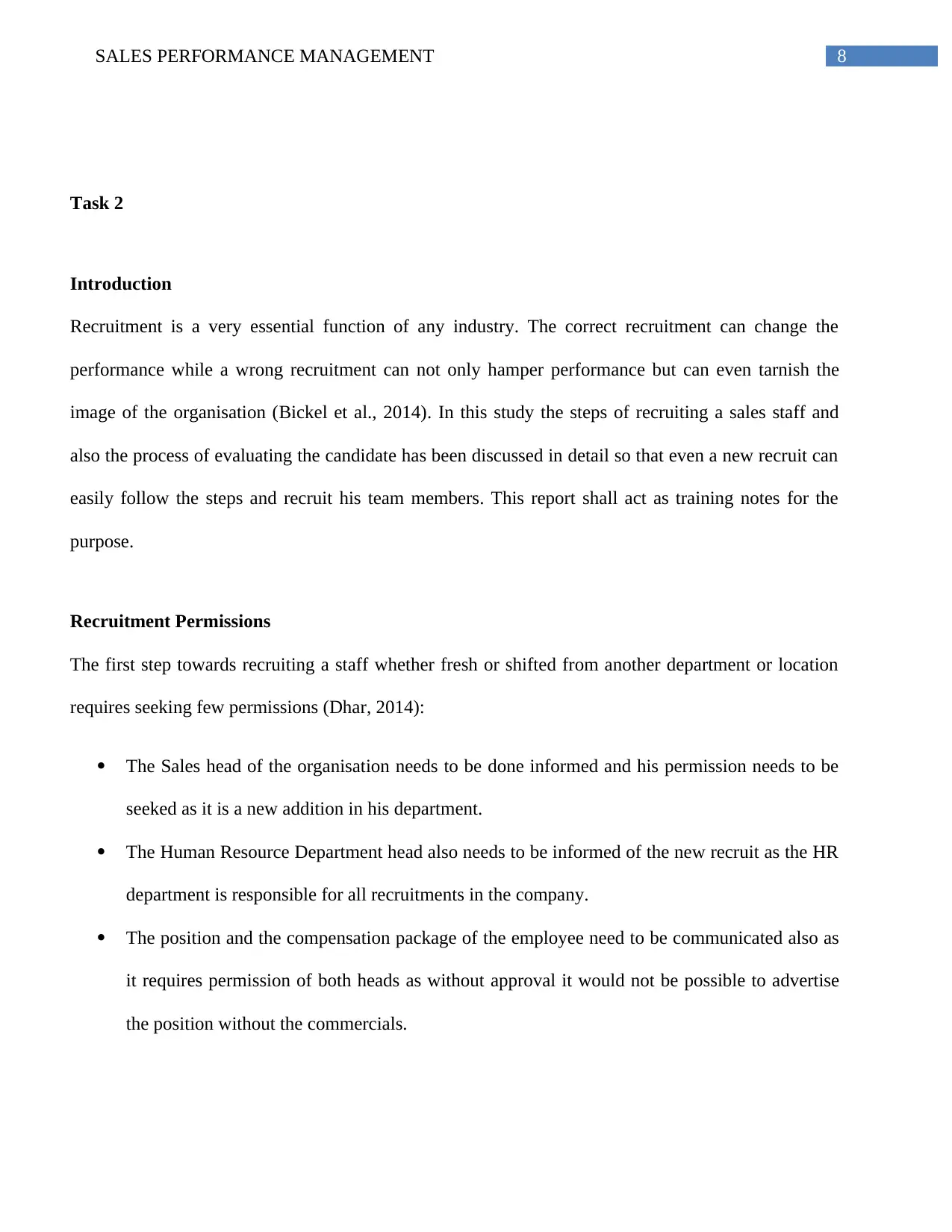
8SALES PERFORMANCE MANAGEMENT
Task 2
Introduction
Recruitment is a very essential function of any industry. The correct recruitment can change the
performance while a wrong recruitment can not only hamper performance but can even tarnish the
image of the organisation (Bickel et al., 2014). In this study the steps of recruiting a sales staff and
also the process of evaluating the candidate has been discussed in detail so that even a new recruit can
easily follow the steps and recruit his team members. This report shall act as training notes for the
purpose.
Recruitment Permissions
The first step towards recruiting a staff whether fresh or shifted from another department or location
requires seeking few permissions (Dhar, 2014):
The Sales head of the organisation needs to be done informed and his permission needs to be
seeked as it is a new addition in his department.
The Human Resource Department head also needs to be informed of the new recruit as the HR
department is responsible for all recruitments in the company.
The position and the compensation package of the employee need to be communicated also as
it requires permission of both heads as without approval it would not be possible to advertise
the position without the commercials.
Task 2
Introduction
Recruitment is a very essential function of any industry. The correct recruitment can change the
performance while a wrong recruitment can not only hamper performance but can even tarnish the
image of the organisation (Bickel et al., 2014). In this study the steps of recruiting a sales staff and
also the process of evaluating the candidate has been discussed in detail so that even a new recruit can
easily follow the steps and recruit his team members. This report shall act as training notes for the
purpose.
Recruitment Permissions
The first step towards recruiting a staff whether fresh or shifted from another department or location
requires seeking few permissions (Dhar, 2014):
The Sales head of the organisation needs to be done informed and his permission needs to be
seeked as it is a new addition in his department.
The Human Resource Department head also needs to be informed of the new recruit as the HR
department is responsible for all recruitments in the company.
The position and the compensation package of the employee need to be communicated also as
it requires permission of both heads as without approval it would not be possible to advertise
the position without the commercials.
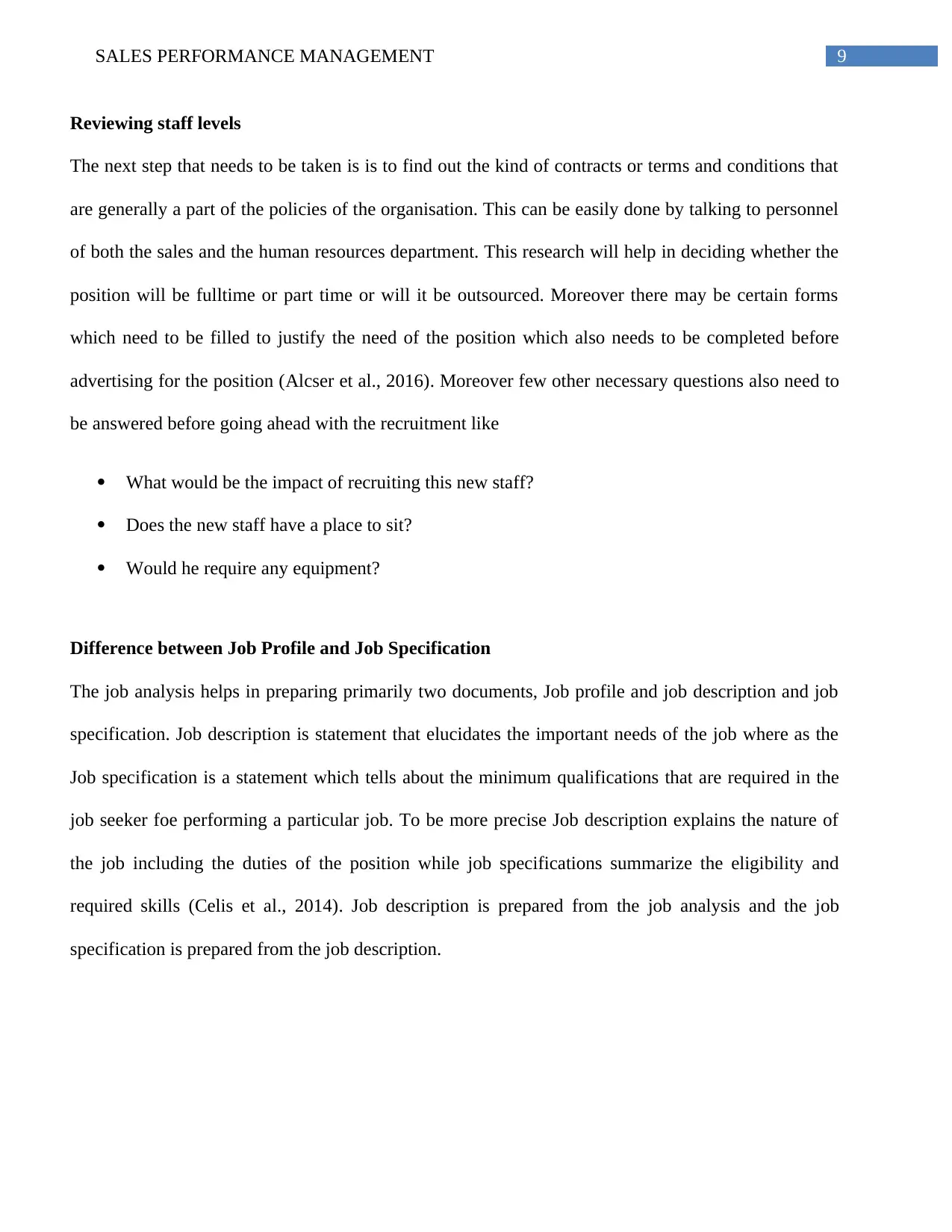
9SALES PERFORMANCE MANAGEMENT
Reviewing staff levels
The next step that needs to be taken is is to find out the kind of contracts or terms and conditions that
are generally a part of the policies of the organisation. This can be easily done by talking to personnel
of both the sales and the human resources department. This research will help in deciding whether the
position will be fulltime or part time or will it be outsourced. Moreover there may be certain forms
which need to be filled to justify the need of the position which also needs to be completed before
advertising for the position (Alcser et al., 2016). Moreover few other necessary questions also need to
be answered before going ahead with the recruitment like
What would be the impact of recruiting this new staff?
Does the new staff have a place to sit?
Would he require any equipment?
Difference between Job Profile and Job Specification
The job analysis helps in preparing primarily two documents, Job profile and job description and job
specification. Job description is statement that elucidates the important needs of the job where as the
Job specification is a statement which tells about the minimum qualifications that are required in the
job seeker foe performing a particular job. To be more precise Job description explains the nature of
the job including the duties of the position while job specifications summarize the eligibility and
required skills (Celis et al., 2014). Job description is prepared from the job analysis and the job
specification is prepared from the job description.
Reviewing staff levels
The next step that needs to be taken is is to find out the kind of contracts or terms and conditions that
are generally a part of the policies of the organisation. This can be easily done by talking to personnel
of both the sales and the human resources department. This research will help in deciding whether the
position will be fulltime or part time or will it be outsourced. Moreover there may be certain forms
which need to be filled to justify the need of the position which also needs to be completed before
advertising for the position (Alcser et al., 2016). Moreover few other necessary questions also need to
be answered before going ahead with the recruitment like
What would be the impact of recruiting this new staff?
Does the new staff have a place to sit?
Would he require any equipment?
Difference between Job Profile and Job Specification
The job analysis helps in preparing primarily two documents, Job profile and job description and job
specification. Job description is statement that elucidates the important needs of the job where as the
Job specification is a statement which tells about the minimum qualifications that are required in the
job seeker foe performing a particular job. To be more precise Job description explains the nature of
the job including the duties of the position while job specifications summarize the eligibility and
required skills (Celis et al., 2014). Job description is prepared from the job analysis and the job
specification is prepared from the job description.
Paraphrase This Document
Need a fresh take? Get an instant paraphrase of this document with our AI Paraphraser
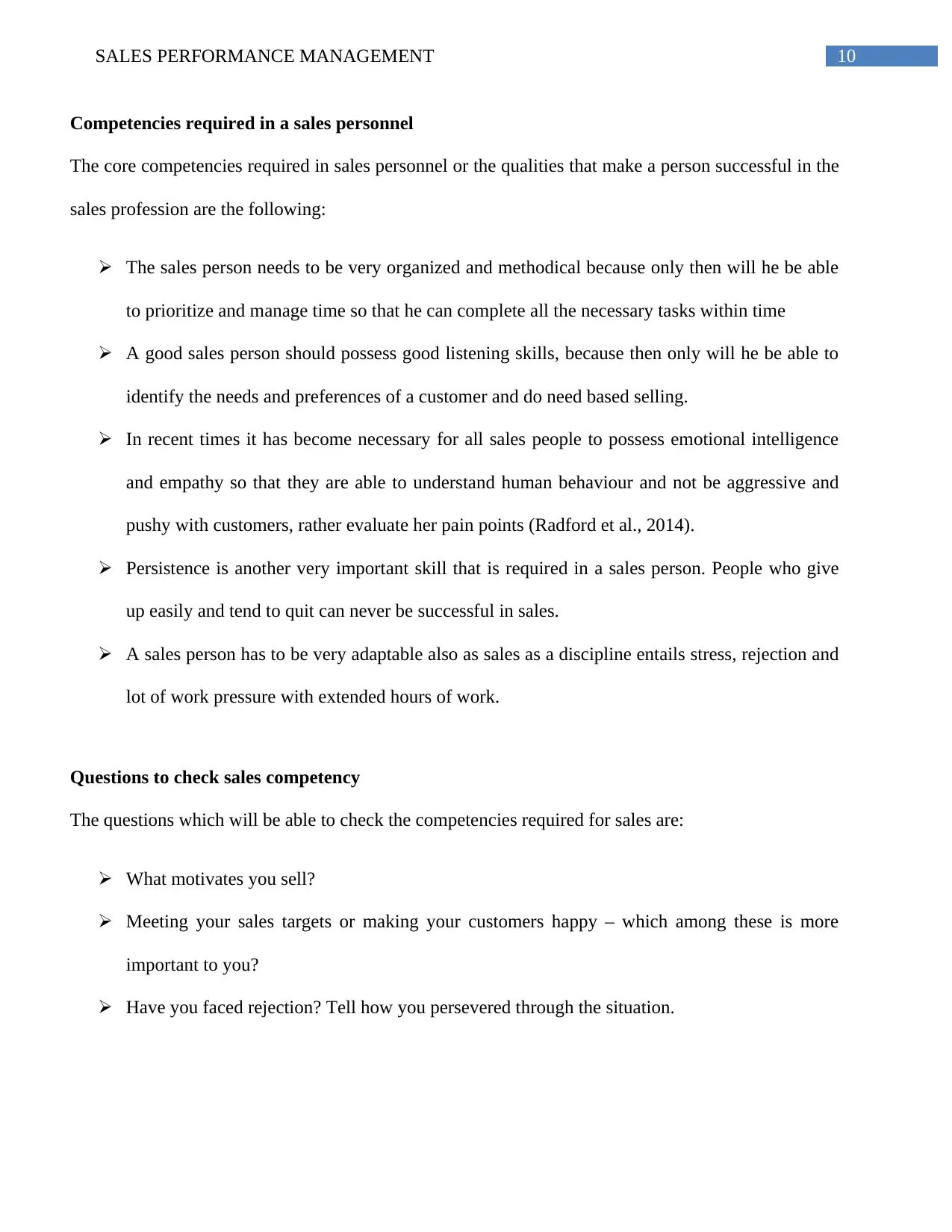
10SALES PERFORMANCE MANAGEMENT
Competencies required in a sales personnel
The core competencies required in sales personnel or the qualities that make a person successful in the
sales profession are the following:
The sales person needs to be very organized and methodical because only then will he be able
to prioritize and manage time so that he can complete all the necessary tasks within time
A good sales person should possess good listening skills, because then only will he be able to
identify the needs and preferences of a customer and do need based selling.
In recent times it has become necessary for all sales people to possess emotional intelligence
and empathy so that they are able to understand human behaviour and not be aggressive and
pushy with customers, rather evaluate her pain points (Radford et al., 2014).
Persistence is another very important skill that is required in a sales person. People who give
up easily and tend to quit can never be successful in sales.
A sales person has to be very adaptable also as sales as a discipline entails stress, rejection and
lot of work pressure with extended hours of work.
Questions to check sales competency
The questions which will be able to check the competencies required for sales are:
What motivates you sell?
Meeting your sales targets or making your customers happy – which among these is more
important to you?
Have you faced rejection? Tell how you persevered through the situation.
Competencies required in a sales personnel
The core competencies required in sales personnel or the qualities that make a person successful in the
sales profession are the following:
The sales person needs to be very organized and methodical because only then will he be able
to prioritize and manage time so that he can complete all the necessary tasks within time
A good sales person should possess good listening skills, because then only will he be able to
identify the needs and preferences of a customer and do need based selling.
In recent times it has become necessary for all sales people to possess emotional intelligence
and empathy so that they are able to understand human behaviour and not be aggressive and
pushy with customers, rather evaluate her pain points (Radford et al., 2014).
Persistence is another very important skill that is required in a sales person. People who give
up easily and tend to quit can never be successful in sales.
A sales person has to be very adaptable also as sales as a discipline entails stress, rejection and
lot of work pressure with extended hours of work.
Questions to check sales competency
The questions which will be able to check the competencies required for sales are:
What motivates you sell?
Meeting your sales targets or making your customers happy – which among these is more
important to you?
Have you faced rejection? Tell how you persevered through the situation.
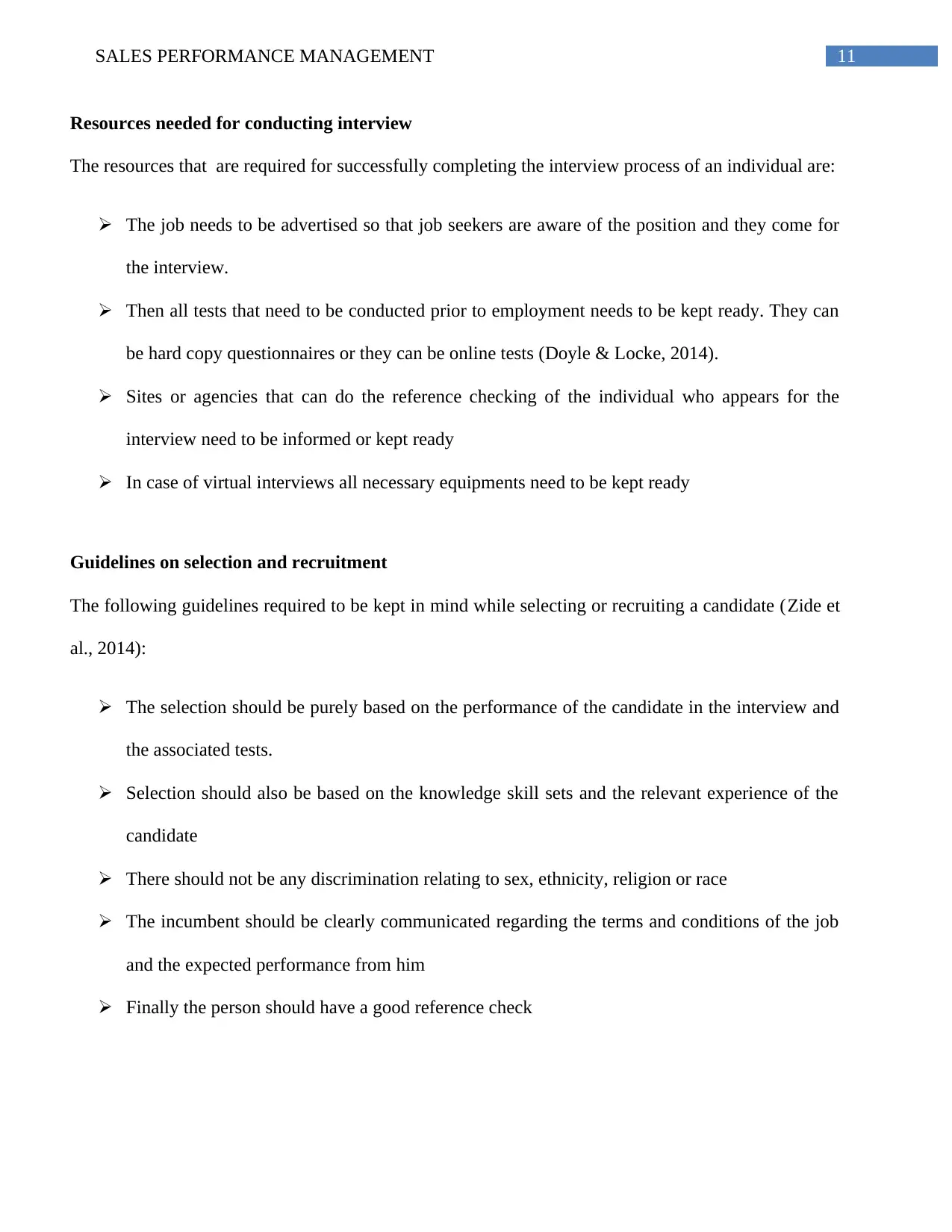
11SALES PERFORMANCE MANAGEMENT
Resources needed for conducting interview
The resources that are required for successfully completing the interview process of an individual are:
The job needs to be advertised so that job seekers are aware of the position and they come for
the interview.
Then all tests that need to be conducted prior to employment needs to be kept ready. They can
be hard copy questionnaires or they can be online tests (Doyle & Locke, 2014).
Sites or agencies that can do the reference checking of the individual who appears for the
interview need to be informed or kept ready
In case of virtual interviews all necessary equipments need to be kept ready
Guidelines on selection and recruitment
The following guidelines required to be kept in mind while selecting or recruiting a candidate (Zide et
al., 2014):
The selection should be purely based on the performance of the candidate in the interview and
the associated tests.
Selection should also be based on the knowledge skill sets and the relevant experience of the
candidate
There should not be any discrimination relating to sex, ethnicity, religion or race
The incumbent should be clearly communicated regarding the terms and conditions of the job
and the expected performance from him
Finally the person should have a good reference check
Resources needed for conducting interview
The resources that are required for successfully completing the interview process of an individual are:
The job needs to be advertised so that job seekers are aware of the position and they come for
the interview.
Then all tests that need to be conducted prior to employment needs to be kept ready. They can
be hard copy questionnaires or they can be online tests (Doyle & Locke, 2014).
Sites or agencies that can do the reference checking of the individual who appears for the
interview need to be informed or kept ready
In case of virtual interviews all necessary equipments need to be kept ready
Guidelines on selection and recruitment
The following guidelines required to be kept in mind while selecting or recruiting a candidate (Zide et
al., 2014):
The selection should be purely based on the performance of the candidate in the interview and
the associated tests.
Selection should also be based on the knowledge skill sets and the relevant experience of the
candidate
There should not be any discrimination relating to sex, ethnicity, religion or race
The incumbent should be clearly communicated regarding the terms and conditions of the job
and the expected performance from him
Finally the person should have a good reference check

12SALES PERFORMANCE MANAGEMENT
Draft Time table for an Interview
Interviewer: Mr. S. John (Sales Manager), Ms. Paula Smith (HR Head), Mr. N. Williams (Training
Head)
All the three people will interview because the concerned departmental heads will try to evaluate the
potential of the candidate.
They might ask questions relating to selling skills, prior experience, and achievements and also give
real life situations and ask the course of action that the incumbent would take.
Conclusion
The above steps need to be followed in sequence to conduct a interview in a methodical and organized
manner. It has to be kept in mind that the behavior and attitude of the interviewer and the
arrangements also helps in creating an impression in the mind of the candidate and helps him in
deciding whether to join the organisation when he is selected.
Draft Time table for an Interview
Interviewer: Mr. S. John (Sales Manager), Ms. Paula Smith (HR Head), Mr. N. Williams (Training
Head)
All the three people will interview because the concerned departmental heads will try to evaluate the
potential of the candidate.
They might ask questions relating to selling skills, prior experience, and achievements and also give
real life situations and ask the course of action that the incumbent would take.
Conclusion
The above steps need to be followed in sequence to conduct a interview in a methodical and organized
manner. It has to be kept in mind that the behavior and attitude of the interviewer and the
arrangements also helps in creating an impression in the mind of the candidate and helps him in
deciding whether to join the organisation when he is selected.
Secure Best Marks with AI Grader
Need help grading? Try our AI Grader for instant feedback on your assignments.

13SALES PERFORMANCE MANAGEMENT
References of Task 2
Alcser, K., Clemens, J., Guyer, H., & Hu, M. (2016). Interviewer recruitment, selection, and
training. Guidelines for best practice in cross-cultural surveys. Survey Research Center,
Institute for Social Research, University of Michigan, Ann Arbor Google Scholar.
Bickel, W. K., Koffarnus, M. N., Moody, L., & Wilson, A. G. (2014). The behavioral-and neuro-
economic process of temporal discounting: a candidate behavioral marker of
addiction. Neuropharmacology, 76, 518-527.
Celis, K., Erzeel, S., Mügge, L., & Damstra, A. (2014). Quotas and intersectionality: Ethnicity and
gender in candidate selection. International Political Science Review, 35(1), 41-54.
Dhar, R. L. (2014). Getting the desired candidate: An exploration of the covert strategies. Work, 47(4),
441-451.
Doyle, D., & Locke, G. (2014). Lacking Leaders: The Challenges of Principal Recruitment, Selection,
and Placement. Thomas B. Fordham Institute.
Radford, A. W., Robles, J., Cataylo, S., Horn, L., Thornton, J., & Whitfield, K. E. (2014). The
employer potential of MOOCs: A mixed-methods study of human resource professionals’
thinking on MOOCs. The International Review of Research in Open and Distributed
Learning, 15(5).
Zide, J., Elman, B., & Shahani-Denning, C. (2014). LinkedIn and recruitment: How profiles differ
across occupations. Employee Relations, 36(5), 583-604.
References of Task 2
Alcser, K., Clemens, J., Guyer, H., & Hu, M. (2016). Interviewer recruitment, selection, and
training. Guidelines for best practice in cross-cultural surveys. Survey Research Center,
Institute for Social Research, University of Michigan, Ann Arbor Google Scholar.
Bickel, W. K., Koffarnus, M. N., Moody, L., & Wilson, A. G. (2014). The behavioral-and neuro-
economic process of temporal discounting: a candidate behavioral marker of
addiction. Neuropharmacology, 76, 518-527.
Celis, K., Erzeel, S., Mügge, L., & Damstra, A. (2014). Quotas and intersectionality: Ethnicity and
gender in candidate selection. International Political Science Review, 35(1), 41-54.
Dhar, R. L. (2014). Getting the desired candidate: An exploration of the covert strategies. Work, 47(4),
441-451.
Doyle, D., & Locke, G. (2014). Lacking Leaders: The Challenges of Principal Recruitment, Selection,
and Placement. Thomas B. Fordham Institute.
Radford, A. W., Robles, J., Cataylo, S., Horn, L., Thornton, J., & Whitfield, K. E. (2014). The
employer potential of MOOCs: A mixed-methods study of human resource professionals’
thinking on MOOCs. The International Review of Research in Open and Distributed
Learning, 15(5).
Zide, J., Elman, B., & Shahani-Denning, C. (2014). LinkedIn and recruitment: How profiles differ
across occupations. Employee Relations, 36(5), 583-604.

14SALES PERFORMANCE MANAGEMENT
1 out of 15
Related Documents
Your All-in-One AI-Powered Toolkit for Academic Success.
+13062052269
info@desklib.com
Available 24*7 on WhatsApp / Email
![[object Object]](/_next/static/media/star-bottom.7253800d.svg)
Unlock your academic potential
© 2024 | Zucol Services PVT LTD | All rights reserved.





